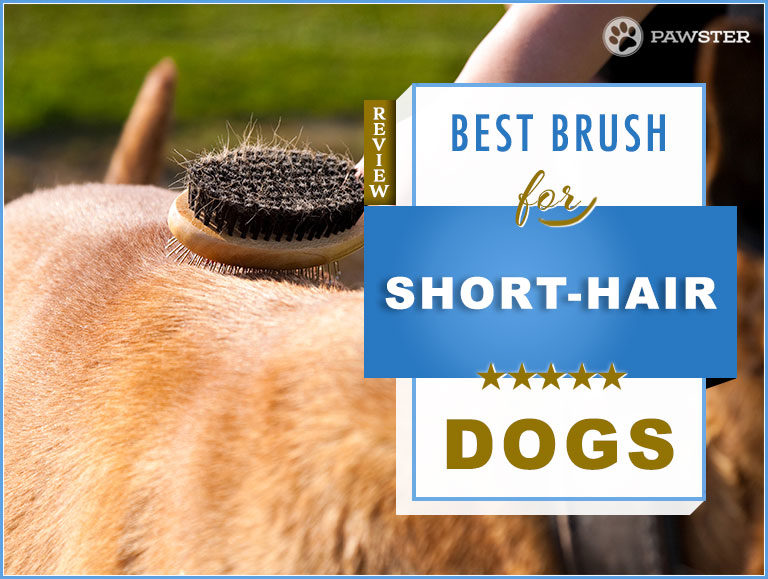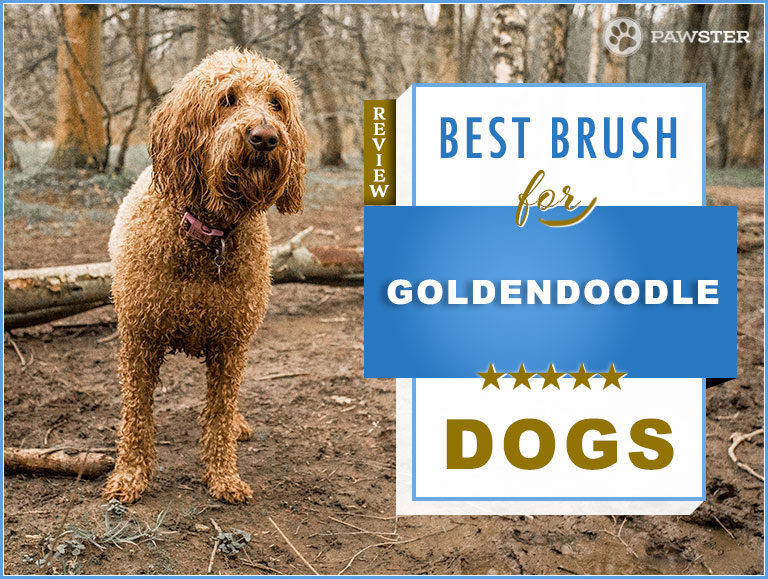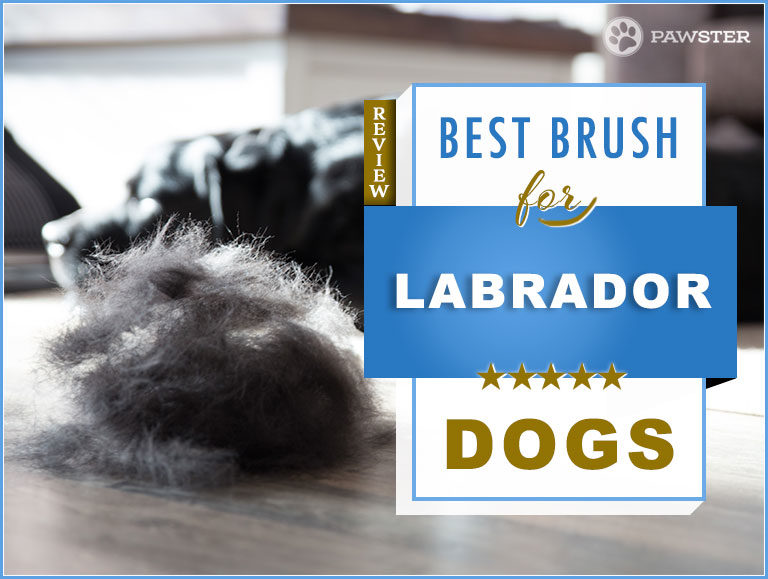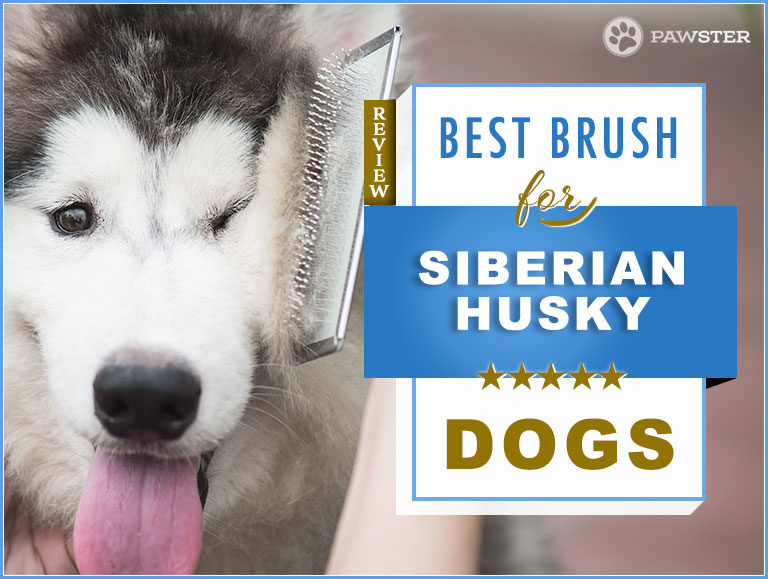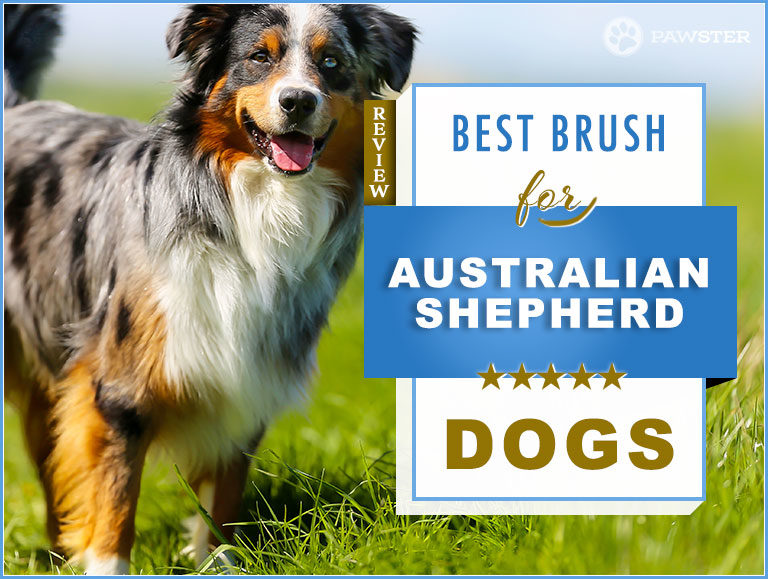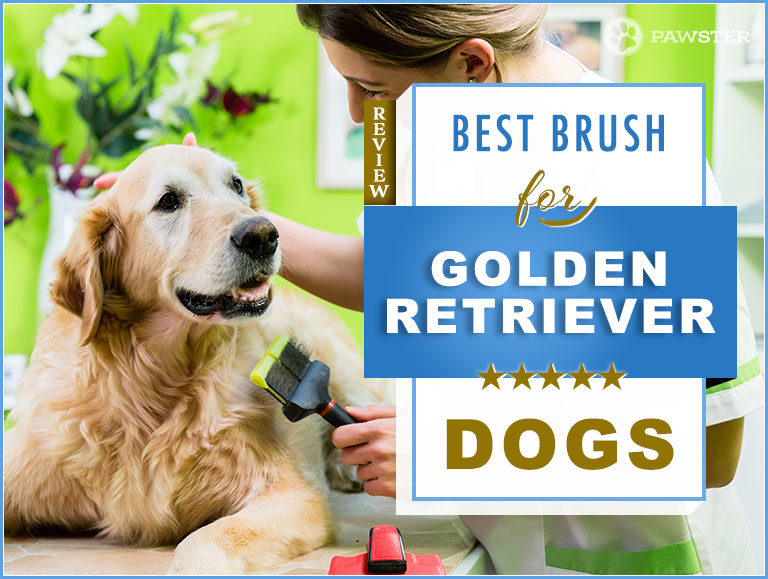Labradoodle Brush: 2024 Picks for Best Labradoodle Dog Brush
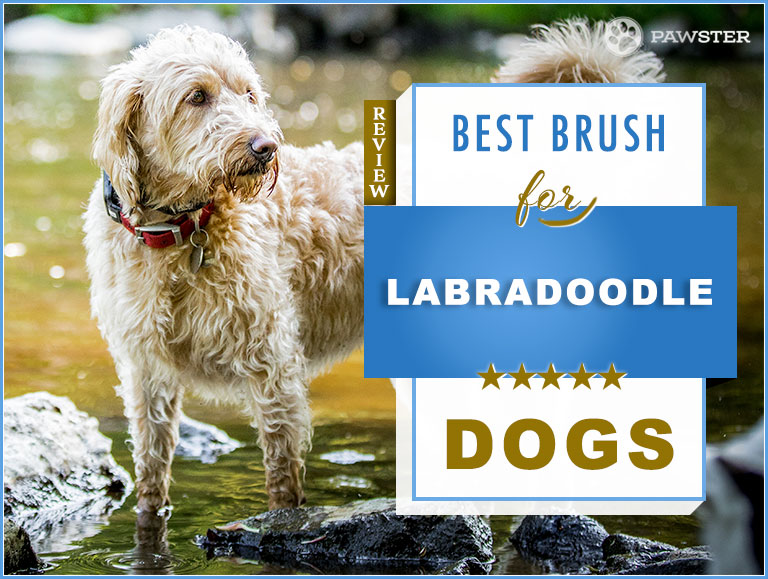
Contents of Article
- What is the Best Brush for a Labradoodle?
- Different Popular Brush Types for Labradoodles
- Understanding Your Labradoodle’s Coat
- Overall Best Brush for a Labradoodle – Hertzko Self Cleaning Slicker Brush.
- Best Labradoodle Matted Hair Brush – Four Paws Magic Coat Instant Dog Mat Remover
- 3 More Top Rated Brushes for Labradoodles
- Tips on Brushing Your Labradoodle’s Coat
- FAQ
- A Unique, Fun-Loving Breed
Labradoodles go by a couple of different names, like Labrapoodle and Labradorpoo. Whatever you call them, any reliable owner will know that they are a unique mix between a Labrador and a Poodle.
Labradoodles are great because their mix creates a breed that has low shedding along with a hypoallergenic coat. At the same time, these pups have adapted that same loving affection that comes from a Labrador.
Since a Labradoodle is a cross breed, it can be difficult to predict exactly how their fur will turn out. For that reason, many Labradoodles have different types of furs.
Regardless of if they inherited mainly Poodle fur or Labrador fur, the fact is that the owners need to take care of their dog’s grooming. Because of their unique coats, we’ve put together this guide to help Labradoodle owners properly take care of their furry friends.
What is the Best Brush for a Labradoodle?
Different Popular Brush Types for Labradoodles
Depending on your Labradoodle’s fur, you may find that you can use a brush that works well with Poodles, Labradors, or combination fur. The first step to determining the brush type you need is determining which type of coat your dog has.
- Shedding blade
- Undercoat rake
- Pin brush
- Metal comb
- Slicker brush
Shedding Blades and Undercoat Rakes
If your Labradoodle has a coat that’s picked up more of the Labrador traits, this means they have a dense, thick coat of short fur. Labradors have double coats, so if your Labradoodle is Lab-leaning, you’ll have to learn the proper care of a double coat. Lab-type coats are often called hair coats.
Because there are two layers of fur to work with, fur can often get trapped under the top coat as it sheds. For this reason, Labradoodles sporting this kind of coat should have a brush that specializes in removing “dead” fur and combing through thick layers.
A couple of brush types that a good for achieving this goal are shedding blades and undercoat rakes. Both of these brushes serve to remove loose fur, detangle, and reach deep into the undercoat.
Slicker Brushes, Pin Brushes, and Rake Brushes
Poodle coats are much easier to handle because they do not have an undercoat. This leaves their fur much less thick than that of a Labrador.
However, Poodle coats are curly, which leaves much more room for tangles and snags that can quickly become mats. You may find that you see a lot less shedding with a more Poodle-ish coat, but that’s because the fur is getting caught and tangled within itself instead of falling straight off. These kinds of coats are often called a wool coat.
Brushes that are good for Poodles include ones that have fine wires close together that can untangle knotted fur and remove mats easily. A few brush types that can accomplish this are slicker brushes, pin brushes, metal combs, and rake brushes.
Use Slicker Brushes on Combination Coats
A combination of the two previously mentioned coats can be varied and widespread. It can be hard to know exactly what kind of comb or brush to use because combination coats can have stronger Labrador features or stronger Poodle features.
Many times, a true combination coat is characterized by its wavy, flowing, and soft texture. These kinds of coats are usually referred to as fleece coats.
Fleece coats are generally easier to maintain than a wool coat because the fur is very soft and manageable—unlike tight curls. Slicker brushes are great for these kinds of coats, as well as pin brushes. They can reach through the tangles and gently remove tough mats and knots.
Understanding Your Labradoodle’s Coat
As we mentioned earlier, Labradoodle coats can vary and are very unique due to the mix of a Labrador and a Poodle.
It’s important to understand that poodles have soft, curly coats, while Labrador’s have dense, double coats that are very thick. Because of this combination, Labradoodle coats can be difficult to manage. In fact, if you don’t practice regular brushing and combing, your pup’s coat can become matted very quickly.
This is because you’re combining the thickness of a Lab with the curly nature of a poodle. You never know how much of either to expect, but you can be certain it won’t be a thin, short-haired coat!
The best way to prevent matting and unruly coats is to brush your dog every day. With a daily routine, you’ll be able to keep up with their tangled fur. You’ll also get your dog used to the idea of being touched with a brush or comb, as some may be timid to the action at first.
Do you know the 9 Best Foods to Feed an Adult and Puppy Labradoodle?
| Our 2024 Picks: Best Dog Brush for Labradoodles | |||
| Rank | Dog Brush | Price | Rating |
| Top Choice |
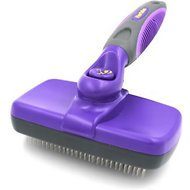 |
$$ |
A+
|
|
#2 |
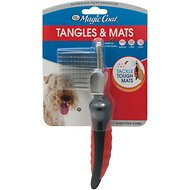 |
$ |
A
|
|
#3 |
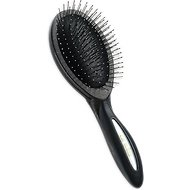 |
$ |
A
|
|
#4 |
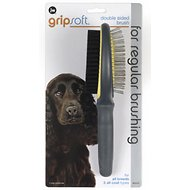 |
$ |
A
|
|
#5 |
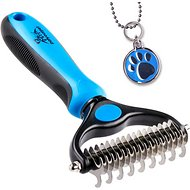 |
$$ |
A-
|
Overall Best Brush for a Labradoodle – Hertzko Self Cleaning Slicker Brush.
Possibly the best brush out there for taming a Labradoodle’s mane is the Hertzko Self Cleaning Slicker Brush. A slicker brush, this tool makes it super easy to get mats, tangles, dander, and stray hairs out of your dog’s coat.
The bristles on this brush are made from fine wires that are bent to reach deep into your pup’s fur without hurting them and scratching their skin. The brush’s gentle toughness is the right level to combat stubborn tangles without harming your fur baby.
In fact, the design of this brush promotes a more massage-like feel that helps increase blood circulation in our dog and gives them a nice, shiny looking coat.
There’s also no need to worry about cleaning out this brush because it offers a feature that basically cleans itself. With the press of a button, you can retract the bristles into the brush, leaving the fur behind and making it incredibly easy to simply brush into the trashcan. You don’t have to worry about pulling knotted fur from between crammed wires.
The comfort grip handle just serves to make your life easier. The anti-slip nature of the brush lets you work through your dog’s coat without losing your grip. It’s also designed to prevent wrist and hand strain over long periods of time.
Pros
- Effective and easy to use
- Comfortable for your hand and wrist
- Easy to clean
- Offers massage feel for pets
- Tough and sturdy
- Removes mats and tangles
Cons
- Does not remove as much as other brushes
- Can feel large in smaller hands
Best Labradoodle Matted Hair Brush – Four Paws Magic Coat Instant Dog Mat Remover
When it comes to mats, it’s best to use brushes with pins that are a little more spread out. Pins that a tightly spaced together won’t be able to comb through a nasty mat. That’s why we like the Four Paws Magic Coat Instant Dog Mat Remover.
Designed specifically for breaking up small and large mats, this brush features a double row of widespread pins that work great on medium, long, and curly coats. With a comfort grip handle, you’ll be able to comfortably sit with your dog to work out frustrating tangles and mats.
Though the pins are durable and tough, the tool is gentle, removing mats without damaging your dog’s coat or skin. It works to pull apart stubborn spots and leave the fur healthy and smooth.
The small head of this brush also gives you more control. It lets you work from the outside in to detangle tough spots without grabbing at unnecessary fur.
Once you have removed the mats in your dog’s fur, you can use other brushes to smooth out the fur and complete your grooming process. This tool is a very important step.
Pros
- Wide teeth are excellent for removing mats
- Works well on skittish pets
- Works quickly
- Collects loose, shedding fur
- Easy to use
Cons
- Not large enough to brush out a whole coat
- Requires a gentle hand so as not to hurt dogs
3 More Top Rated Brushes for Labradoodles
It’s always great to have options when you’re shopping around. We can recommend what we think is the best product, but everyone has different preferences and ideas of what they think is best.
For that reason, we’ve listed a few other excellent options for Labradoodle brushes that have great ratings and quality features.
Andis Premium Pin Brush
This Andis product is an excellent pin brush that is two-sided and great for detangling Labradoodle fur. As we mentioned before, pin brushes work great for combination fur that includes traits from both Labrador and Poodle fur.
One side of this brush holds coarse pins while the other has fine bristles. The large pins work to loosen up dense fur that has become tangled and matted. You can then use the bristle side to brush through the rest of your pup’s coat to make it smooth and shiny.
We also love the sturdy, comfortable handle that this brush has. It uses salon style grips that let you easily use the brush for a long period of time without hurting your hand.
Pros
- Salon quality handle for comfort
- Two sides for untangling and daily brushing
- Excellent for combination fur
- Smooth ball ends are easy on pet skin
- Great for de-shedding
Cons
- Not very durable
- Hard to clean out
JW Pet Gripsoft Double Sided Brush
Another convenient two-sided brush, we love the JW Pet version for its comfortable handle that gives you the perfect holding grip with every use.
Not only is the brush gentle on your hands, but it’s gentle on your dog. Your Labradoodle will love the rounded ends on the pin side that don’t scratch at their skin and cause irritation. The pins are durable and long enough to reach deep into undercoats while remaining gentle enough for short hair.
Among the pins, there is a hole in the base of the brush that allows airflow, letting the base flex and move to match the contours of your dog’s body.
On the other side, the bristle brush lets you brush through your dog’s coat, catching loose hair and dirt and leaving them soft and groomed.
Pros
- Comfort handle
- Double-sided for detangling and brushing
- Long, sturdy pins reach undercoats
- Airflow allows brush to contour to pet’s body
- Catches loose hair and dirt
- Gentle on pets
Cons
- Large for small hands and young dogs
- Doesn’t hold onto fur very well
Pat Your Pet Pet Two Sided Undercoat Rake
This 2-in-1 tool is an excellent solution for both matted fur and shedding. The dual head has two sides: the 9-teeth side for mats and the 17-teeth side for de-shedding.
The first side uses a widespread set of teeth with a sharp inside to cut through tough mats. Though part of this tool is sharp, it is completely safe for your pet. The outer edge of these teeth is smooth and rounded, which not only prevents harm to your pup’s skin but provides a gentle massage for comfort and circulation.
On the other side of the tool, you have 17 teeth that work to thinning out the fur and remove loose hair. As you brush, the comb gently pulls out shedding fur and collects in, promoting health and shine.
The comfortable grip is great on your hands and wrist, and the stainless-steel teeth are designed to be durable and easy to clean. This is a great tool for Labradoodles as it works with a variety of fur, from thin to thick and curly.
Pros
- Sharp teeth cut through mats easily
- Dual sides work to detangle and remove loose hair
- Stainless steel teeth are durable
- Easy to clean
- Safe for your pet
- Massages skin
Cons
- Snags sometimes
- Not good for deep undercoats
Tips on Brushing Your Labradoodle’s Coat
Now that you’ve got some ideas for the tools you’re going to use on your Labradoodle’s coat, it’s time we also gave you a few helpful tips to make the grooming process easier.
Stay Consistent
It’s recommended that you brush your Labradoodle’s fur every day. Sure, we understand that you may miss a day or two here and there. The important thing is that you remain consistent. If you brush your dog’s fur regularly, there’s less of a chance they will show up with heavy duty tangles or large mats. Frequent grooming is a must for coats like theirs.
Quality Matters
The quality of your actual brushing strokes does matter. Experts recommend that for a Labradoodle, you should brush to the skin and work from under the coat. They also say that you will have the easiest time if you work from the feet up to the body, and then to the tail and the head.
Always brush is the direction that your dog’s fur grows. You should never brush against the grain, as this not only disturbs the flow of their fur and does not give them a clean look, but it can also be uncomfortable for your pup.
With each stroke of your brush, you should slowly add small amounts of the coat. Don’t try to brush across his whole body or comb through large sections at once. Take it slow and go small section by small section.
Outdoor Dogs
Outdoor dogs need more brushing than those who spend most of their time indoors. When your pup runs around outside a lot, he’s dealing with the wind tangle his fur as well as dirt, twigs, and even other animals messing it up.
If your dog spends a lot of time outside, he’ll need to be brushed more frequently than if he remains indoors.
Tools
Invest in a set of grooming tools rather than just buying one brush. Some dual brushes may prove to be enough for some dogs, but other dogs may need specific tools for de-matting, shedding, and general brushing or combing.
Bathing
Bathe your dog every one to two weeks. Not only is this necessary for general grooming maintenance and health, but it makes brushing his fur much easier. This is especially true if he’s gotten himself into something sticky. You should never try to brush through a sticky clump of fur before cleaning it first.
FAQ
How often should you brush a Labradoodle?
Technically, you should try to brush your Labradoodle every day. However, with today’s business surrounding us, we all know how difficult that can be to accomplish. Aim for a brushing at least once a week. If your dog is very active and gets himself into trouble a lot, you may want to brush him every few days for your own sake.
How to prevent Labradoodle’s hair from matting?
The best way to prevent matting is regular brushing. By brushing out his hair on a consistent basis, you don’t allow it to have the chance to mat. This also goes back to regular bathing. Clean fur is less likely to mat than dirty fur. You should also have your dog participate in regular trimming. The longer the fur grows, the more likely it is to become heavily tangled.
Do Labradoodles have an undercoat?
The exact measure of a Labradoodle’s coat can never really be guaranteed since it’s a mixture of a Poodle, which does not have an undercoat, and a Labrador, which does have an undercoat.
Because of their two very different coats, there’s a chance you could have a Labradoodle with a more Poodle-intense coat without an undercoat, but there’s also a chance you get a Labradoodle that’s more on the Labrador side. In the latter case, you most likely will have an undercoat.
How do you prevent a labradoodle from shedding so much?
While there’s not really any way you can “stop” a labradoodle—or any dog, for that matter—from shedding, there are things you can do to lessen the amount of fur that gets on your furniture, rugs, and clothing.
A Unique, Fun-Loving Breed
Labradoodles are popular pups to own. While they’re most known for their hypoallergenic coat, people also love them because they are active, friendly, and loving.
Like with any pet or any dog breed, you need to learn how to care for your fur baby properly. By following simple grooming guides and being armed with the right kinds of brushes and combs, you can keep your Labradoodle’s coat healthy and shiny, which will ultimately keep your pup happy and healthy.

